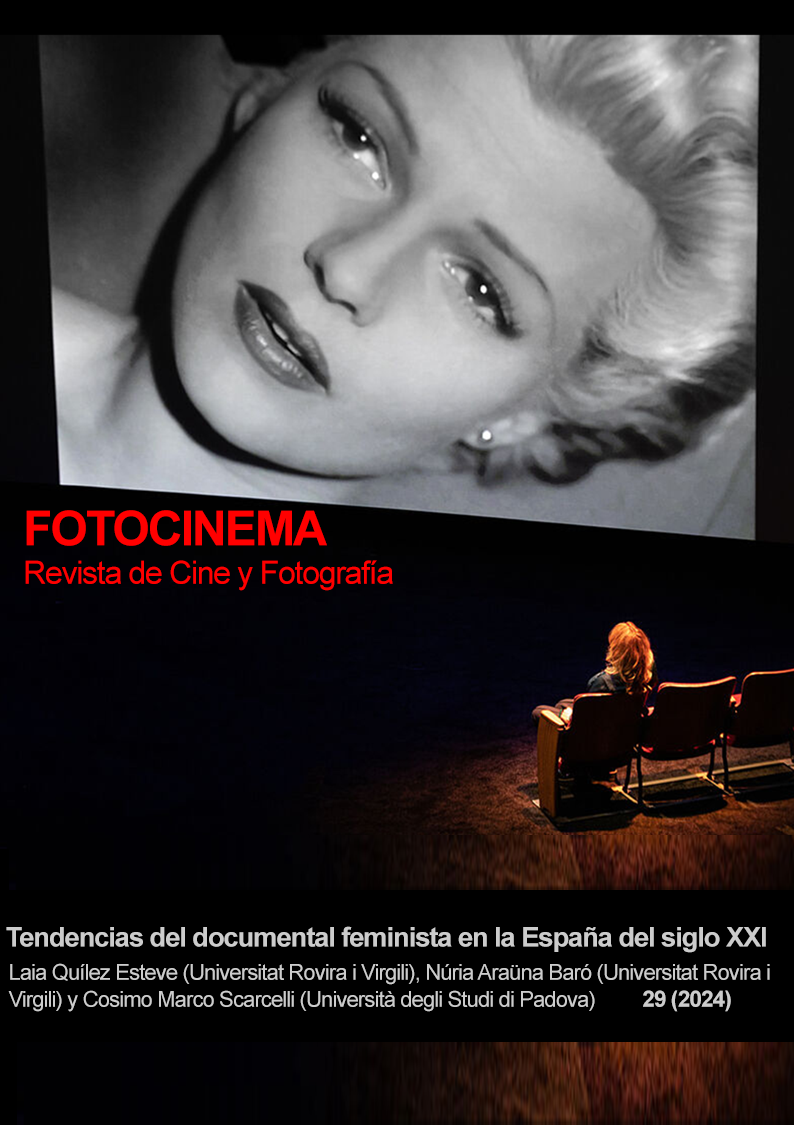Call history. The Latency of Archive in the spaces and the bodies of Nación, Una revuelta sin imágenes and Una dedicatoria a lo bestia
DOI:
https://doi.org/10.24310/fotocinema.29.2024.19171Keywords:
Archive, history and experience, filmic mediums, performativity, real allegoryAbstract
Three documentary films retake some neglected fights of women in the dawn of the 21st Century in Spain: Bread riots in 17th century, endurance to the forced confinement during Francoism and resistance to industrial restructuring during PostTransition. Bodies and spaces turn into archive; memory and history are convened there; inside them a new feminist and class archive is built. Nación (Ledo, 2020), Una revuelta sin imágenes (Monsell, 2020) y Una dedicatoria a lo bestia (NucBeade, 2019) look back using historiographical techniques through images; they experiment with the aesthetic possibilities of time, regeneration and phantasmatic film possibilities. They rebuild history and its women’s embodiment. These films are mostly situated at the industrial margins –low-cost feature film, a short film and a video-essay– but they place themselves at the head of documentary renovation: these films experiment with form, recover nonobvious archive, think about the image and defy the documentary film boundaries, even creating real allegories.
Downloads
Metrics
Publication Facts
Reviewer profiles N/A
Author statements
Indexed in
-
—
- Academic society
- N/A
- Publisher
- Universidad de Málaga
References
Balázs, B. (2013). El hombre visible o la cultura del cine. El cuenco de plata.
Berger, J. (2016). Modos de ver. Gustavo Gili.
Berton, M. (2021). Cinema, fantômes et médiums. Critique. Le grand rétour des fantômes, (884-885), 106-116. https://doi.org/10.3917/criti.884.0106
Benjamin, W. (2006a). Charles Baudelaire. Un lírico en la época del altocapitalismo. En W. Benjamin, Obras (Libro I, vol. 2). Abada.
Benjamin, W. (2006b). Sobre el concepto de historia. En W. Benjamin, Obras (Libro I, vol. 2). Abada.
Cabanès, J-L. y Reverzy, É. (2011). Allégories réelles. Romantisme, (152), 39-60. http://doi.org/10.3917/rom.152.0039
Català, J. M. (2023). El futuro imaginario del documental. En M. Torreiro y A. Alvarado (Eds.), El documental en España: Historia, estética e identidad (pp. 458-476). Cátedra.
Català, J. M. (2021). Posdocumental. La condición imaginaria del cine documental. Shangrila.
Cuevas, E. (2022). Filming history from below. Microhistorical documentaries. Columbia University Press.
Didi-Huberman, G. (2008). La Ressemblance par contact. Archéologie, anachronisme et modernité de l’empreinte. Éditions de Minuit.
Elsaesser, T. y Hagener, M. (2015). Introducción a la teoría del cine. UAM.
Jay, M. (2011). In the Realm of the Senses: An Introduction. The American Historical Review, 116(2), 307-315.
Kirsten, G., Cuter E. y Prenzel, H. (Eds.). (2022). Precarity in European Film. Depictions and Discourses. De Gruyter.
Kracauer, S. (2002). De Caligari a Hitler. Una historia psicológica del cine alemán. Paidós.
Ledo, M. (28 de junio de 2021). “Margarita Ledo: Nación son as mulleres da miña xeración”. Entrevista de José Manuel Sande a Margarita Ledo. Luzes. https://luzes.gal/20/03/2021/seccions-da-revista-luzes/entrevistas/margarita-ledo-nacion-son-as-mulleres-da-mina-xeracion/
Ledo, M. (2020). El cuerpo y la cámara. Cátedra.
Martín, A., Bleda, M. y Rosa, J. M. (2010). Bleda y Rosa hablan con Alberto Martín. En Conversaciones con fotógrafos (pp. 129-174). La Fábrica.
Mulvey, L. y Wollen, P. (2016). Entrevista con Laura Mulvey a propósito de 'Riddles of the Sphinx' por Scott MacDonald. Lumière. http://elumiere.net/exclusivo_web/seff16/entrevistamulvey.php
Pérez-Pereiro, M. y Roca-Baamonde, S. (2024). A Women’s Nation: Feminism, Class, and National Identity in Margarita Ledo Andión’s Nación (2020). Hispanic Research Journal, 24(1), 3-20, https://doi.org/10.1080/14682737.2024.2333142
Périot, J. G. y Brossat, A. (2018). Ce qui peut le cinéma. Conversations. La Découverte.
Rediker, M. (2022). Reflections on history from below. Trashumante. Revista Americana de Historia Social, (20), 296-299.
Rediker, M. (2021). Entre el deber y el motín. Lucha de clases en mar abierto. Antipersona.
Rich, A. (1986) Notes towards a Politics of location (1984). En Blood, Bread and Poetry (pp. 210-231). Norton & Cia.
Schmidt, P. (2024). Gustave Courbert. L’Atelier du peintre. Musée d’Orsay https://www.musee-orsay.fr/es/obras/latelier-du-peintre-927
Selva, M. y Solà, A. (2023). Feminismos y cineastas en el documental español. En M. Torreiro y A. Alvarado (Eds.), El documental en España: Historia, estética e identidad (pp. 290-304). Cátedra.
Selva, M. (2005). Desde una mirada feminista: los nuevos lenguajes del documental. En C. Torreiro y J. Cerdán (Coords.), Documental y vanguardia (pp. 65-84). Cátedra.
Thompson, E. P. (2019). Costumbres en común. Estudios sobre la cultura popular. Capitán Swing.
Toussaint, H. (1982). La liberté guidant le peuple de Delacroix. Réunion des Musées Nationaux.
Traverso, E. (2022). Revolución. Una historia intelectual. Akal.
Traverso, E. (2011). El pasado, instrucciones de uso. Historia, memoria, política. Prometeo.
Downloads
Published
How to Cite
Issue
Section
License
Copyright (c) 2024 Mª Soliña Barreiro

This work is licensed under a Creative Commons Attribution-NonCommercial-NoDerivatives 4.0 International License.
All contents published in Fotocinema Revista científica de cine y fotografía are protected under the Creative Commons Attribution-NonCommercial-ShareAlike 4.0 International (CC BY-NC-SA 4.0) license. All about this license is available in the following link: <http://creativecommons.org/licenses/by-nc-sa/4.0>
Users can copy, use, redistribute, share and exhibit publicly as long as:
- The original source and authorship of the material are cited (Journal, Publisher and URL of the work).
- It is not used for comercial purposes.
- The existence of the license and its especifications are mentioned.
There are two sets of authors’ rights: moral and property rights. Moral rights are perpetual prerogatives, unrenounceable, not-transferable, unalienable, imprescriptible and inembargable. According to authors’ rights legislation, Fotocinema. Revista científica de cine y fotografía recognizes and respects authors moral rights, as well as the ownership of property rights, which will be transferred to University of Malaga in open access. The property rights are referred to the benefits that are gained by the use or the dissemination of works. Fotocinema. Revista científica de cine y fotografía is published in an open access form and it is exclusively licenced by any means for doing or authorising distribution, dissemination, reproduction, , adaptation, translation or arrangement of works.
Authors are responsable for obtaining the necessary permission to use copyrighted images.














13.png)



